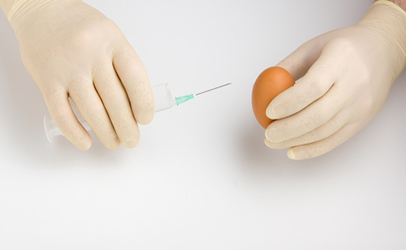 are in many commonly consumed foods – eggnog, hollandaise sauce and mayonnaise, to name a few – and since about one of every 20,000 chicken eggs in the U.S. runs a high risk of containing Salmonella bacteria, the only way to be sure these bacteria are killed is to hard-boil the eggs or pasteurize them via hot-water immersion.
are in many commonly consumed foods – eggnog, hollandaise sauce and mayonnaise, to name a few – and since about one of every 20,000 chicken eggs in the U.S. runs a high risk of containing Salmonella bacteria, the only way to be sure these bacteria are killed is to hard-boil the eggs or pasteurize them via hot-water immersion.However, doing either of those things changes the taste, texture and color of the eggs, qualities that some consumers find objectionable. Now, prototype research studies by scientists at the Agricultural Research Service (ARS) and Princeton University have found that raw eggs artificially infected with Salmonella bacteria can be zapped almost completely free of it by using radio waves, and that these waves, combined with a subsequent hot-water bath, can more quickly pasteurize eggs without objectionable after-effects.
As published this month in Agricultural Research magazine, the study tested 4,000 fresh, raw shell eggs by heating them with energy from radio waves – also known as radiofrequency, or RF, heating – and simultaneously spraying them with water to cool them. Finally, the eggs were put in a hot-water bath. This entire pasteurization process took about 20 minutes, or about one-third that of the conventional one.
Eggs were also inoculated with a research strain of Salmonella and treated to the RF-based process, which killed 99.999 percent of the cells, according to ARS chemical engineer Dave Geveke.
Although using RF heating to kill pathogens in foods isn’t new, the study report noted that using RF heating to kill pathogens in eggs is novel. Also, Geveke said, the new process is safe and effective and is expected to be cost-efficient.
Geveke has been working for the past two years on the process with Christopher Brunkhorst of the Princeton Plasma Physics Laboratory in Plainsboro, NY, and ARS chemical engineering technician Andy Bigley. The three have applied for a patent for their research, and several egg-processing companies have already expressed an interest in the technology.
Commercial use of their RF-based method is at least a year or so away, and Geveke expects to begin pilot-scale tests this year. After that, regulatory approval would be needed.
Part of the U.S. Food and Drug Administration’s Food Code specifies the use of raw pasteurized eggs or other pasteurized egg product in place of unpasteurized eggs when foods such as Caesar salad, hollandaise or Béarnaise sauce, mayonnaise, meringue, eggnog, ice cream, and egg-fortified beverages are served to “highly susceptible populations” and/or those in nursing homes, hospitals or senior care centers.
Certain Salmonella strains are associated with eating raw or undercooked eggs and can cause diarrhea, stomach cramps, fever, and possibly even be fatal. Salmonellosis particularly affects infants, preschoolers, pregnant women, elderly people and anyone with a compromised immune system.







